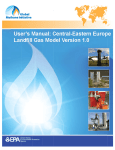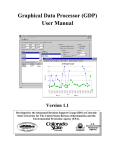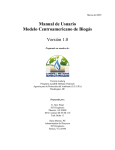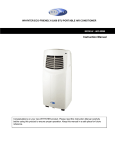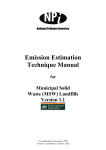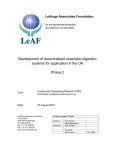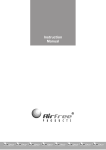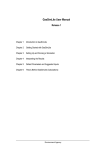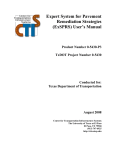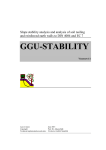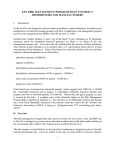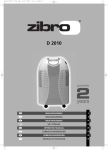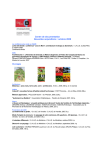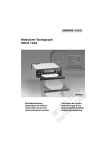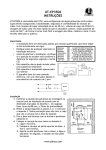Download Phillippines Landfill Gas Model User Manual
Transcript
December 2009 User's Manual Philippines Landfill Gas Model Version 1.0 Prepared on behalf of: Rachel Goldstein Landfill Methane Outreach Program U.S. Environmental Protection Agency Washington, D.C. Prepared by: Clint Burklin, P.E. Eastern Research Group, Inc. Morrisville, NC 27560 and Bryce Lloyd Organic Waste Technologies (Hong Kong) Limited Hong Kong SAR, China EPA Contract EP-W-06-022 Task Order 36 DISCLAIMER This user’s manual has been prepared specifically for Philippines on behalf of the U.S. EPA’s Landfill Methane Outreach Program, U.S. Environmental Protection Agency. The methods contained within are based on engineering judgment and represent the standard of care that would be exercised by a professional experienced in the field of landfill gas projections. The U.S. EPA and its contractors ERG and OWT do not guarantee the quantity of available landfill gas, and no other warranty is expressed or implied. No other party is intended as a beneficiary of this work product, its content, or information embedded therein. Third parties use this report at their own risk. The U.S. EPA and its contractors ERG and OWT assume no responsibility for the accuracy of information obtained from, compiled, or provided by other parties. ABSTRACT This document is a user's manual for a computer model, Version 1.0 of a landfill gas (LFG) generation model for estimating LFG generation and recovery from existing or future municipal solid waste (MSW) landfills in Philippines (Philippines Landfill Gas Model v 1.0; referred to as Philippines LFG Model hereafter). The model was developed by ERG and OWT under contract to the U.S. EPA’s Landfill Methane Outreach Program (LMOP). The Philippines LFG Model can be used to estimate LFG generation rates from landfills, and potential LFG recovery rates for landfills that have, or plan to have, gas collection and control systems in Philippines. The Philippines LFG Model is an Excel® spreadsheet model based on a first order decay equation. The model requires the user to input site-specific data for landfill opening and closing years, refuse disposal rates, history of landfill fires, and a number of landfill characteristics that determine LFG collection efficiency. Based on the site-specific data supplied by the user, the model selects recommended values for input variables, including methane generation rate constant (k), potential methane generation capacity (L 0 ), collection efficiency, and fire discount factor and estimates generation and recovery rates. Users can also specify their own values for these input variables, provided the information is reliable. The recommended values for input Philippines Landfill Gas Model v1.0 User’s Manual 12/2009 ii variables were developed using data on climate, waste characteristics, and disposal practices in Philippines, and the estimated effect of these conditions on the amounts and rates of LFG generation. The Philippines LFG Model was developed with the goal of providing general estimation of LFG generation and recovery potential. Other models evaluated during the model development process included the U.S. EPA Central America Landfill Gas Model Version 1 (EPA, 2007), the U.S. EPA China Landfill Gas Model Version 1.1 (EPA, 2009), and the Intergovernmental Panel on Climate Change (IPCC) 2006 Waste Model. The Philippines LFG Model incorporates components of each of these models that help it to reflect conditions at disposal sites in Philippines. Philippines Landfill Gas Model v1.0 User’s Manual 12/2009 iii TABLE OF CONTENTS Section Page DISCLAIMER ................................................................................................................................ ii ABSTRACT.................................................................................................................................... ii LIST OF FIGURES ........................................................................................................................ v LIST OF TABLES.......................................................................................................................... v GLOSSARY OF TERMS .............................................................................................................. vi 1.0 INTRODUCTION.......................................................................................................... 1-1 1.1 1.2 Landfill Gas Generation ....................................................................................... 1-3 1.1.1 Methane Generation Rate Constant (k)................................................... 1-4 1.1.2 Ultimate Methane Generation Potential (L0).......................................... 1-6 1.1.3 Landfill Fires ........................................................................................... 1-7 Landfill Gas Recovery.......................................................................................... 1-7 1.2.1 1.3 2.0 3.0 Estimating Collection Efficiency ............................................................ 1-8 The Model .......................................................................................................... 1-12 ESTIMATING LANDFILL GAS GENERATION AND RECOVERY ................... 2-1 2.1 Model Inputs......................................................................................................... 2-1 2.2 Model Output - Table ........................................................................................... 2-6 2.3 Model Output - Graph .......................................................................................... 2-8 REFERENCES ............................................................................................................... 3-1 Philippines Landfill Gas Model v1.0 User’s Manual 12/2009 iv LIST OF FIGURES Figure 1- Model Inputs Figure 2 - Model Inputs (Continued) Figure 3 - Sample Model Output Table Figure 4 - Sample Model Output Graph LIST OF TABLES Table 1 - Landfill Collection Efficiency Philippines Landfill Gas Model v1.0 User’s Manual 12/2009 v GLOSSARY OF TERMS TERM DEFINITION Closure Year The year in which the landfill ceased, or is expected to cease, accepting waste. Collection Efficiency The estimated percentage of generated landfill gas that is or can be collected by a gas collection system. Collection System Area Coverage The percentage of the landfilled area that has (or will have) a comprehensive and operating landfill gas collection system. Landfill Fire Uncontrolled combustion of waste placed in a landfill. Landfill fires can be above ground or underground (subsurface). Signs of landfill fires include smoke (especially from cracks and fissures in the waste mass), elevated gas temperature and carbon monoxide levels, smoke-stained gas vents, smoldering wastes, excessive settlement, etc. Landfill Gas Landfill gas is a product of biodegradation of refuse in landfills and consists of primarily methane and carbon dioxide, with trace amounts of non-methane organic compounds and air pollutants. Methane Generation Rate Constant (k) k is a model constant that determines the estimated rate of landfill methane generation. The first-order decomposition model assumes that k values before and after peak landfill gas generation are the same. k is a function of moisture content in the landfill refuse, availability of nutrients for methanogens, pH, and temperature. (Units = 1/year) Opening Year The year in which the landfill begins, or is expected to begin, accepting waste. Philippines Landfill Gas Model v1.0 User’s Manual 12/2009 vi TERM Ultimate Methane Generation Potential (L 0 ) Philippines Landfill Gas Model v1.0 User’s Manual 12/2009 DEFINITION L 0 is a model constant that represents the potential capacity of a landfill to generate methane (a primary constituent of landfill gas). L 0 depends on the amount of degradable organic carbon in the refuse. (Units = cubic meters per megagram (m3/Mg)) vii 1.0 INTRODUCTION The Philippines Landfill Gas Model (Philippines LFG Model) provides an automated estimation tool for quantifying landfill gas (LFG) generation and recovery from existing or future municipal solid waste (MSW) landfills across Philippines. This manual provides an introduction to the model and step-by-step instructions for using the model. The main purpose of the Philippines LFG Model is to provide landfill owners, operators, and potential developers with a tool to evaluate the feasibility and potential benefits of collecting and using the generated LFG for energy recovery or other uses. To accomplish this purpose, this computer model provides estimates of potential LFG recovery rates and available emission reductions. This is accomplished using the LFG generation rates estimated by the model and estimates of the efficiency of the collection system in capturing generated gas, known as the collection efficiency. The model provides LFG recovery estimates by multiplying the LFG generation by the estimated collection efficiency; potentially available emission reductions estimates are obtained by multiplying the LFG recovery estimates by the methane content, the density of methane, and the global warming potential of methane (21). The model also estimates energy output from either a direct use project or an electricity generation project. Landfill gas is generated by the decomposition of refuse in the landfill, and can be recovered through the operation of gas collection facilities installed at the landfill. The following information is needed to estimate LFG generation and recovery from a landfill (see the Glossary of Terms): The annual refuse disposal rate for the landfill; The methane generation rate (k) constant; The ultimate methane generation potential (L 0 ); The collection efficiency of the gas collection system; Whether there are (and/or have been) landfill fires at the site; and The opening and closure years of the landfill. Philippines Landfill Gas Model v1.0 User’s Manual 12/2009 1-1 The model employs a first-order exponential decay function that assumes that LFG generation is at its peak following a time lag representing the period prior to methane generation. The model assumes a six month time lag between placement of waste and LFG generation. For each unit of waste, after six months the model assumes that LFG generation decreases exponentially as the organic fraction of waste is consumed. For sites with known (or estimated) year-to-year solid waste disposal rates, the model estimates the LFG generation rate in a given year using the following equation, which is used by the U.S. EPA’s Landfill Gas Emissions Model (LandGEM) version 3.02 (EPA, 2005). QΜ Where: QM i n j k L0 Mi t ij C CH4 = = = = = = = = = 1 C CH4 n 1 kL i l j 0.1 O Mi 10 kt ij e maximum expected LFG generation flow rate (m3/yr); 1 year time increment (year of the calculation) – (initial year of waste acceptance) 0.1 year time increment methane generation rate (1/yr); ultimate methane generation potential (m3/Mg); mass of solid waste disposed in the ith year (Mg); age of the jth section of waste mass disposed in the ith year (decimal years). methane concentration (volume fraction). The above equation is used to estimate LFG generation for a given year from each increment of waste disposed up through that year. Multi-year projections are developed by varying the projection year, and then re-applying the equations. The year of maximum LFG generation normally occurs in the closure year or the year following closure (depending on the disposal rate in the final years and the value of the methane generation rate constant). The Philippines LFG Model requires site-specific data for all the information needed to produce generation estimates, except for the k and L 0 values. The model uses recommended default values for k and L 0 based on calculations using waste composition data gathered from representative landfills in different cities in Philippines, in accordance with the methodology presented in the IPCC 2006 guidelines (IPCC, 2006). The recommended default k and L 0 values Philippines Landfill Gas Model v1.0 User’s Manual 12/2009 1-2 are used to produce typical LFG generation estimates for landfills in Philippines. Users can also specify their own values for k and L 0 provided that the information is reliable. The Philippines LFG Model also requires the user to provide information, either actual or anticipated/planned, on certain landfill construction and operation characteristics that determine the collection efficiency of the existing or potential future gas collection system. Based on the information provided by the user, the model would recommend a value for the collection efficiency. The recommended collection efficiency would then be used in combination with the LFG generation estimates to arrive at LFG recovery estimates. The user also has the option to input an alternative collection efficiency assumption or a site-specific collection efficiency. EPA recognizes that modeling LFG generation and recovery accurately is difficult due to limitations in available information for inputs to the model. However, as new landfills are constructed and operated, and better information is collected, the present modeling approach can be improved. In addition, as more landfills in Philippines develop gas collection and control systems, additional data on LFG generation and recovery will become available for model calibration and the development of improved model recommended values. Questions and comments concerning the Philippines LFG model should be directed to Rachel Goldstein of EPA’s LMOP at (202) 343 9291, or e-mail to [email protected]. 1.1 Landfill Gas Generation The Philippines LFG Model estimates LFG generation resulting from the biodegradation of refuse in landfills. The anaerobic decomposition of refuse in solid waste landfills generates LFG. The composition of MSW LFG is assumed by the model to be approximately 50 percent methane (CH 4 ) and 50 percent other gases, primarily carbon dioxide (CO 2 ) with trace amounts of other compounds. Philippines Landfill Gas Model v1.0 User’s Manual 12/2009 1-3 This computer model uses a first-order decomposition rate equation and estimates volumes of LFG generation in cubic meters per minute (m3/min) and cubic meters per hour (m3/hr). Methane generation is estimated using two parameters: (1) L 0 is the ultimate methane generation potential of the refuse, and (2) k is the methane generation rate constant. For a unit of waste, LFG generation is assumed to be at its peak the first year following placement in the landfill. The model provides recommended default values of L 0 and k based on values calculated using IPCC methodology and waste composition data from a number of landfills in different locations of Philippines, adjusted through experience; however, the model also allows the user to enter L 0 and k values derived using site-specific data collected at the landfill. 1 1.1.1 Methane Generation Rate Constant (k) The methane generation rate constant, k, determines the rate of generation of methane from refuse in the landfill. Its unit is 1/year, and describes the rate at which refuse placed in a landfill decays and produces biogas. The higher the value of k, the faster total methane generation at a landfill increases (as long as the landfill is still receiving waste) and then declines (after the landfill closes) over time. The value of k is a function of the following factors: (1) refuse moisture content, (2) availability of nutrients for methane-generating bacteria, (3) pH, and (4) temperature. Different waste types can have significantly different k values as a result of differences in decay rates. Food waste, for example decays faster than paper or wood. The k value also varies with climate, especially temperature, precipitation, and evapotranspiration. To calculate the k value using IPCC methodologies, a landfill location has to be categorized as “cold or hot” and “dry or wet” based on the following two criteria in accordance with Table 3.4 in the IPCC 2006 Guidelines: Cold vs. Hot: A location is “cold” if the mean annual temperature (MAT) is 20oC or lower 1 Site-specific L 0 and k values may be developed for landfills with operating gas collection and control systems by calibrating the Philippines LFG Model using known landfill gas recovery data; alternatively, L 0 and k values can be Philippines Landfill Gas Model v1.0 User’s Manual 12/2009 1-4 A location is “hot” if the MAT is higher than 20oC Based on available information, practically all locations in Philippines have a MAT value that is higher than 20 oC and thus should be categorized as “hot”. Dry vs. Wet: For “hot” locations, It is dry if the mean annual precipitation (MAP) is less than 1000 millimeters (mm) It is wet if the MAP is 1000 mm or more Based on available information, most locations in Philippines have a MAP value that is more than 1000 mm and thus should be categorized as “wet”. For “cold” locations, It is dry if the ratio of mean annual precipitation (MAP) to potential evapotranspiration (PET) is less than 1 It is wet if the ratio of MAP to PET is greater than 1 Using the above two criteria, each location in Philippines can then be classified as belonging to one of the following two climatic zones (or regions): Region 1: Hot and Wet Region 2: Hot and Dry Based on available information, most locations in Philippines would be classified as “Hot and Wet”, although there could be isolated locations that might qualify as “Hot and Dry”. It should be noted that there are no “Cold and Wet” or “Cold and Dry” locations in Philippines. Unless a user-specified k value is entered into the Philippines LFG Model, the model uses a recommended default value of k based on the assumption that the landfill location is “Hot and Wet”. The recommended value of k was developed based on a value calculated using IPCC methodology and average waste composition from a number of landfills in different locations of estimated based on climate and waste composition using IPCC methodologies (IPCC, 2006). Philippines Landfill Gas Model v1.0 User’s Manual 12/2009 1-5 Philippines, adjusted through experience. The recommended default k value for Philippines, assuming a “Hot and Wet” location, is 0.18. If the user has reliable data that indicate the mean annual precipitation (MAP) at the landfill location is less than 1000 mm, and/or the average water content of the waste in the landfill is relatively low (e.g., less than 30%), it would be more appropriate to use a k value that corresponds to “Hot and Dry” conditions. Using the average waste composition data for Philippines, the value of k calculated using IPCC methodologies would be approximately 0.10. The user can enter the selected value in the model as a user-specified value to override the recommended default value. 1.1.2 Ultimate Methane Generation Potential (L 0 ) Except in dry climates where a lack of moisture limits methane generation, the value for the ultimate methane generation potential of refuse (L 0 ) depends almost exclusively on the type of refuse present in the landfill. The higher the biodegradable organic carbon content of the refuse, the higher the value of L 0 . The units of L 0 are in cubic meters of methane per metric tonne of refuse, which means that the L 0 value describes the total amount of methane gas potentially produced by a metric tonne of refuse as it decays over its lifetime. The values of theoretical and obtainable L 0 range from 6.2 to 270m3/Mg refuse (EPA, 1991). Unless a user-specified L 0 value is entered into the Philippines LFG Model, the model uses a recommended default value of L 0 . The recommended default value of L 0 is based on a value calculated using IPCC methodology and average waste composition from a number of landfills in different locations of Philippines, adjusted through experience. The recommended L 0 value for Philippines is 60m3/Mg. Although the value of L 0 does not depend on the climate zone per se, it does depend on the water content of the waste as it is defined in terms of the total weight of the waste. Therefore, given the same waste composition, waste in a dry location with a lower water content would have a higher value of L 0 than waste in a wet location with a higher water content. Philippines Landfill Gas Model v1.0 User’s Manual 12/2009 1-6 Therefore, if the user has reliable data that indicate the mean annual precipitation (MAP) at the landfill location is less than 1000 mm, and/or the average water content of the waste in the landfill is relatively low (e.g., less than 30%), it would be more appropriate to use a L 0 value that corresponds to “dry” conditions. Using the average waste composition data for Philippines, the value of L 0 would be approximately 70m3/Mg. The user can enter the selected value in the model as a user-specified value to override the recommended default value. 1.1.3 Landfill Fires Landfill fires have been reported or observed at a number of landfills in Philippines. Landfill fires can be above ground or underground (subsurface). Once fires are started, especially subsurface landfill fires, they are very difficult to extinguish or control. Signs of landfill fires include smoke (especially from cracks and fissures in the waste mass), elevated LFG temperatures or carbon monoxide levels, smoke-stained gas vents, smoldering wastes, and accelerated settlement. Landfill fires can consume a significant amount of the organic matter and thus drastically reduce the LFG generation rate. Landfill fires can also damage the LFG collection system, poison the methanogenic bacteria, and reduce the collection efficiency. For landfills where current or past landfill fires have been observed or are likely present, a reduction of 20 to 40% in the methane estimate might occur as the combined result of loss of organics and damaged collection system. If the user indicates that signs of current or past landfill fires were observed, the model applies a default fire discount factor (30% percent reduction) to the methane estimate. 1.2 Landfill Gas Recovery Landfill gas generated in landfills can be captured by gas collection and control systems that typically burn the gas in flares or, alternatively, the collected gas can be used beneficially. Beneficial uses of LFG include use as fuel in energy recovery facilities, such as internal combustion engines, gas turbines, microturbines, steam boilers, furnaces, kilns, or other equipment that uses the gas as fuel to generate electricity or useable heat. Philippines Landfill Gas Model v1.0 User’s Manual 12/2009 1-7 In addition to the energy benefits from the use of LFG, collection and control of generated LFG helps to reduce emissions that are harmful to the environment. Control of LFG destroys methane, which is a greenhouse gas that contributes to global climate change. Control of LFG also destroys organic compounds that could adversely affect human health. The collection and control of LFG also reduces the potential for methane migration, both on-site and off-site, thus mitigating the risks of explosions or fires. 1.2.1 Estimating Collection Efficiency Collection efficiency is a measure of the ability of the gas collection system to capture generated LFG. It is a percentage value that is applied to the LFG generation projection produced by the model to estimate the amount of LFG that is or can be captured for flaring or beneficial use. Although rates of LFG capture can be measured, rates of generation in a landfill cannot be measured (hence the need for a model to estimate generation); therefore there is considerable uncertainty regarding actual collection efficiencies achieved at landfills. In response to the uncertainty regarding collection efficiencies, the U.S. EPA (EPA, 1998) has published what it believes are reasonable collection efficiencies for landfills in the United States (U.S.) that meet U.S. design standards and have “comprehensive” gas collection systems. According to the U.S. EPA, collection efficiencies at such landfills typically range from 60% to 85%, with an average of 75%. A comprehensive LFG collection system is defined as a system of vertical wells and/or horizontal collectors providing 100%collection system coverage of all areas with waste within one year after the waste is deposited. Most landfills, particularly those that are still receiving wastes, have less than 100%collection system coverage, and require a “coverage factor” adjustment to the estimated collection efficiency. Sites with security issues or large numbers of uncontrolled waste pickers will not be able to install equipment in unsecured areas and cannot achieve comprehensive collection system coverage. Table 1, “Landfill Collection Efficiency,” shows an example of how to estimate the collection efficiency using responses to several questions related to landfill construction and Philippines Landfill Gas Model v1.0 User’s Manual 12/2009 1-8 operation to determine discounts to the collection efficiency. For example, if the responses are “Yes” to questions 1 to 2 and 4 to 7 and “No” to question 3, then there is no discount beyond the collection efficiency value of 85% related to questions 1 to 7. Furthermore, if the LFG System Area Coverage Percentage falls in bracket I, then the final estimated collection efficiency is 85% times the Area Coverage Factor (ACF) (0.95 in this case), or approximately 81%. TABLE 1: LANDFILL COLLECTION EFFICIENCY Collection Efficiency Discount (below 85%) No. Question Yes No 1 Is the waste placed in the landfill properly compacted on an ongoing basis? 0% 3% 2 Does the landfill have a focused tipping area? 0% 5% 3 Are there leachate seeps appearing along the landfill side slopes? Or is there ponding of water/leachate on the landfill surface? 10% 0% Is the average depth of waste 10 m or greater? Is any daily or weekly cover material applied to newly deposited waste? Is any intermediate/final cover applied to areas of the landfill that have reached interim or final grade? 0% 10% 0% 10% 0% 5% 7 Does the landfill have a geosynthetic or clay liner? 0% 5% 8 In which bracket (I to V) does the LFG System Area Coverage Percentage fall? 4 5 6 Multiply by Area Coverage Factor (see below) The LFG System Area Coverage Percentage is defined as the percentage of the landfilled area that has a comprehensive and operating LFG collection system; brackets I to V are defined in the table below. The collection efficiency would be reduced by the ACF, which is estimated in accordance with the following table: LFG System Area Coverage Percentage Philippines Landfill Gas Model v1.0 User’s Manual 12/2009 Bracket 1-9 Area Coverage Factor (ACF) 80 – 100% 60 – 80% 40 – 60% 20 – 40% < 20% I II III IV V 95% 75% 55% 35% 15% Note that the recommended method for estimating collection efficiency assumes that some portion (at least 15%) of generated LFG will escape collection, no matter how well designed the landfill or how comprehensive the gas collection system is. The following steps are recommended to adjust the efficiency below 85%: To evaluate collection efficiency, start at 85%, and then apply a discount based on the responses to each of seven questions, as described in Table 1 and below. We suggest a 3% discount for “No” to Question 1, a 5% discount for “No” to Question 2, a 10% discount for “Yes” to Question 3, a 10% discount each for “No” to Questions 4 and 5, and a 5% discount each for “No” to Questions 6 and 7 (i.e., a maximum of 48% discount to the collection efficiency) for the seven questions. Question 1 asks whether the waste placed in the landfill is properly compacted on an ongoing basis. The response should be “Yes” only if the incoming waste is compacted thoroughly as the waste is placed (or if the waste arrives at the landfill already compacted and baled). Thorough and timely compaction of the waste placed in the landfill reduces the amount of air (thus oxygen) in the waste mass, promoting anaerobic decomposition that generates LFG. Proper compaction of the waste would also minimize differential settlement (thus reducing potential problems with the collection piping), and decrease the amount of surface water infiltration (thus lowering the amount of leachate). Question 2 asks whether the landfill has a focused tipping area. The response should be “Yes” only if the tipping area is smaller than approximately 30 m by 30 m. A focused tipping area minimizes the area through which air and surface water can infiltrate into the waste mass. It is also a good landfill practice as there would be less exposed waste, thereby minimizing odor and pest nuisances. Question 3 asks whether there are leachate seeps appearing along the landfill side slopes, and whether there are ponds of water/leachate on the landfill surface. The response should be “No” only if there are neither leachate seeps nor ponds of water/leachate. The absence of leachate seeps and surficial ponds of water/leachate is indicative of a relatively well-drained waste mass with low leachate levels, which is beneficial to LFG collection. Question 4 asks whether the average depth of waste is 10 m or greater. The response should be “Yes” only if the depth of waste averaged over the entire landfill exceeds 10 m. Since the waste close to the top of the landfill tends to decompose aerobically and does not contribute to LFG generation, a shallower landfill would have a lower apparent collection efficiency since it has a larger proportion of such waste. Philippines Landfill Gas Model v1.0 User’s Manual 12/2009 1-10 Question 5 asks whether any daily or weekly cover material is applied to newly deposited waste. The response should be “Yes” only if newly deposited waste is covered with an appropriate material (such as soil, plastic tarp, or geosynthetics) on a regular basis, preferably daily but at least weekly; material with large voids such as gravels, construction and demolition debris or leaves and branches are not considered appropriate cover material. The timely application of appropriate cover material to newly deposited waste is essential to minimize the amount of rapidly decomposing waste (such as food waste) that undergoes aerobic decomposition; it is also necessary for the reduction of air and surface water infiltration and thus promote anaerobic decomposition. Furthermore, it allows the collection system to operate under the necessary vacuum without drawing excessive air/oxygen into the system. Question 6 asks whether any intermediate/final cover is applied to areas of the landfill that have reached interim or final grade. The response should be “Yes” only if areas of the landfill that have reached interim or final grade receive an intermediate or final cover in a timely manner; i.e., preferably within one year of reaching such grades. Similar to daily or weekly cover, it is also necessary for the reduction of air and surface water infiltration, and allows the collection system to operate under the necessary vacuum. Question 7 asks whether the landfill has a geosynthetic or clay liner. The response should be “Yes” only if most, if not all, of the landfill has a properly designed bottom liner made of geosynthetics, clay or other appropriate material. Question 8 is related to the LFG System Area Coverage Percentage, namely in which bracket (I to V) does it fall. The LFG System Area Coverage Percentage is defined as the percentage of the landfill area that has a comprehensive and operating LFG collection system. The response to Question 8 should be selected based on the value of the LFG System Area Coverage Percentage according to the following table: LFG System Area Coverage Percentage 80 – 100% 60 – 80% 40 – 60% 20 – 40% < 20% Bracket I II III IV V The estimation of collection efficiency has been partly automated in the model; the adjustment of the collection efficiency below 85% will be performed automatically, if a “Yes” or “No” response is provided to each of the seven questions. The model will also select the appropriate ACF, if the bracket (I to V) in which the LFG System Coverage Percentage falls is identified. The model will then reduce the adjusted collection efficiency by the ACF to calculate Philippines Landfill Gas Model v1.0 User’s Manual 12/2009 1-11 the final collection efficiency. Users can also specify their own value for the collection efficiency, if the information is reliable. 1.3 The Model The Philippines LFG Model can be operated in a Windows 2000®, Windows XP®, or Vista environment. The program is a Microsoft Excel® spreadsheet. Open the model file (“LMOP Philippines Model_v1-0.xls”) by choosing “file,” “open,” and then “open” when the correct file is highlighted. To enable the model to run correctly, the user will need to “enable macros” when prompted; since high security settings may automatically disable macros, it may be necessary to change the computer’s security settings to enable macros. The model has three worksheets as follows: A model inputs worksheet; A model output worksheet in a table format; and A model output worksheet in a graph format. Only the inputs worksheet is accessible initially. The output table and output graph worksheets will become accessible, once all necessary information has been entered, by clicking on the “View Output Table” and “View Output Graph” buttons. When using the model, all of the editing by the user should take place in the model inputs worksheet. Philippines Landfill Gas Model v1.0 User’s Manual 12/2009 1-12 2.0 2.1 ESTIMATING LANDFILL GAS GENERATION AND RECOVERY Model Inputs All model inputs are entered into the model inputs worksheet. Cells highlighted in yellow require user inputs. See Figure 1 for model inputs. The following inputs are required to run the model properly and produce acceptable outputs (tables and graphs). If the landfill is an existing landfill, the inputs should be based on recorded data and actual conditions (where available), although inputs based on anticipated (or planned) conditions can be entered in some steps to obtain hypothetical estimates for evaluation purposes. For future landfills, by definition, inputs can only be based on anticipated (or planned) conditions. Step 1. Enter the landfill name and title of the case study/project (Cell E10). The information entered here will automatically appear in the first heading of the output table and the output graph. Step 2. Enter the location (city and province) of the landfill (Cell E11). The information entered here will automatically appear in the second heading of the output table and the output graph. Step 3. Enter the year the landfill opened and began receiving waste (Cell E12). This value will feed into the annual landfill activity data table below and into the output table. Step 4. Enter the year the landfill closed (or is projected to close) (Cell E13). This value will feed into the annual landfill activity data table below and into the output table. Step 5. Enter the expected methane content of the LFG (Cell E14). This value will be used to calculate the net flow of the recovered gas. It is recommended that this value be left at 50% unless specific information is available from the site that warrants a different value. Steps 6 through 14 are required if you want the model to recommend values for k, L 0 , collection efficiency, and fire discount factor. You can skip to Step 15 if you have reliable information on these parameters and would like to enter site-specific values for these parameters (except the fire discount factor) instead. Philippines Landfill Gas Model v1.0 User’s Manual 12/2009 2-1 Indicate whether there are signs of current or past subsurface fires at the landfill. This will impact the L 0 value. Step 6. The following eight steps require the user to provide information on the construction and operation of the landfill that determines the collection efficiency of the gas collection system. For Steps 7 through 13, select “Yes” or “No” as appropriate in response to each question; for Step 14, select the appropriate bracket (I to V) based on the value of the LFG System Area Coverage Percentage. Detailed discussions on how to select the appropriate responses to these eight questions were presented in Section 1.2.1. Step 7. Is the waste placed in the landfill properly compacted on an ongoing basis? Step 8. Does the landfill have a focused tipping area? Step 9. Are there leachate seeps appearing along the landfill side slopes? Or are there ponds of water/leachate on the landfill surface? Step 10. Is the average depth of waste 10 m or greater? Step 11. Is any daily or weekly cover material applied to newly deposited waste? Step 12. Is any intermediate/final cover applied to areas of the landfill that have reached interim or final grade? Step 13. Does the landfill have a geosynthetic or clay liner? Step 14. Which bracket (I to V) applies to the LFG System Area Coverage? The LFG System Area Coverage Percentage is defined as the percentage of the landfill area that has a comprehensive and operating LFG collection system. LFG System Area Coverage Percentage 80 – 100% 60 – 80% 40 – 60% 20 – 40% < 20% Bracket I II III IV V If you do not have sufficient information to answer all of the questions in Steps 7 through 14, the model will not provide a recommended value for the collection efficiency. In such case, Philippines Landfill Gas Model v1.0 User’s Manual 12/2009 2-2 you can skip to Step 15 to enter an assumed/nominal value for collection efficiency. For a typical landfill constructed and operated in accordance with the state of practice in Philippines, it is reasonable to use 25 to 40% as the collection efficiency before landfill closure /completion of the gas collection system and 50 to 65% subsequently. FIGURE 1 – MODEL INPUTS Step 15. Review the values of k, L 0 , collection efficiency, and fire discount factor recommended by the model based on his inputs in Steps 6 through 14. These appear under “Model Recommended Value.” If you wish to change one or more of these values, or if you did not complete Steps 6 through 14 and want to enter site-specific value(s) for one or more of these parameters (except for the fire discount factor), enter the preferred value(s) under “User Recommended Value.” Specifically, enter single values for k, L 0 , and collection efficiency into Cells H43 through H45, respectively. This should be done only if you have reliable site-specific information on these parameters, or if you do not have sufficient information to answer the questions in Steps 7 through 14 and would like to enter an assumed/nominal value for the collection efficiency. If you enter a value for collection efficiency into cell H45, then the model will feed it into the annual landfill activity data table below and use it to estimate the LFG recovery rates. Philippines Landfill Gas Model v1.0 User’s Manual 12/2009 2-3 Step 16. For collection efficiency, if you want to enter different values for different years, enter them into the corresponding cells in Column 4 of the Annual Landfill Activity Data table, see Figure 2. If not, skip to Step 17. The model defaults to assume that each year’s collection efficiency is the same as the previous year; therefore, values for collection efficiency need to be entered only in the years it changes. For example, if the landfill improves (or plans to improve) the gas collection system or puts a final cap in place during a given year, you might want to enter a higher collection efficiency in Column 4 for that year. The model will automatically apply that collection efficiency to the subsequent years. Step 17. Enter the average or actual annual waste disposal rate for the landfill in the opening year in Column 2 of the Annual Landfill Activity Data table (Cell E56). The model defaults to assume that the annual disposal rate for the years between the opening year and the closure year (inclusive) remains constant. If you want to enter different disposal rates for different years, continue to Step 18; otherwise, skip to Step 19. Step 18. Enter the amount of waste disposed (in metric tonnes) for each year the site is open in Column 2, see Figure 2. The model accommodates up to 100 years of waste disposal history or projection. The model defaults to assume that each year’s waste disposal amount is the same as that of the previous year; therefore, values for amount of waste disposed needs to be entered only in the years it changes. The disposal estimates should be based on available records of actual disposal rates and be consistent with site-specific data on amount of waste in place, total site capacity, and projected closure year. For years without historical data, adjust the disposal amounts until the calculated total tonnes in place matches estimated actual tonnes in place (as of the most recent year with waste-in-place data). Step 19. Enter the actual LFG recovery rates in cubic meters per hour (for sites with active gas collection systems) in Column 5 of the Annual Landfill Activity Data table (see Figure 2). This should be the average annual total LFG flow at the flare station and/or energy recovery plant (NOT the sum of flows at individual wells) and is usually based on gas flow measurements. If the measured methane content was not entered in Step 5, adjust all flow rates to 50% methane equivalent by multiplying the measured flow by the measured methane content of the LFG and then dividing the result by 50% as indicated in the table below. (This is not necessary if the measured methane content was entered in Step 5.) The numbers placed in these cells will be displayed as data points in the graph output sheet, so do not input zeros for years with no flow data (leave blank instead). The actual measured values entered will not change the gas generation and recovery curves. Comparing the gas recovery projected by the model to actual data points provides an indication of how well the model is predicting gas recovery at the landfill. Equation for adjusting methane content to 50%: Measured Flow Rate Philippines Landfill Gas Model v1.0 User’s Manual 12/2009 X Measured methane % 50 % methane 2-4 = Flow rate at 50% methane FIGURE 2 - MODEL INPUTS (continued) Philippines Landfill Gas Model v1.0 User’s Manual 12/2009 2-5 2.2 Model Output - Table Model results are displayed in a table located in the model “Output Table” worksheet (see Figure 3 for a sample table layout). The model output - table worksheet (and the model output - graph worksheet) is accessible only after all required information has been entered in the model input worksheet. The titles of the table have been set by user inputs in the model inputs worksheet. The table provides the following information, which was either copied from the model inputs worksheet or calculated by the model: Projection years starting with the landfill opening year and continues for 100 years in total. Annual disposal rates. Cumulative amount of waste in place at the end of each projection year. LFG generation rates for each projection year in cubic meters per minute and cubic meters per hour. Collection system efficiency for each projection year. LFG recovery rates for each projection year in cubic meters per minute and cubic meters per hour. Carbon dioxide equivalent of recoverable methane gas in metric tonnes per year (MTCO 2 e/year). Potentially available energy output from a direct use project in megajoules per hour (MJ/hr) (assuming the gas is combusted in a boiler with 85% efficiency to produce steam). Potentially available energy output from a electric generation project in megawatts (MW) (assuming the gas is combusted in an engine with 30% efficiency to produce electricity). Philippines Landfill Gas Model v1.0 User’s Manual 12/2009 2-6 Beneath the table, the following information is provided: The methane content assumed for the model projection (50%, unless changed by the user in the Inputs worksheet). The k value used for the model run. The L 0 value used for the model run. To print the table, select “File”, “Print”, “OK”. FIGURE 3 - SAMPLE MODEL OUTPUT TABLE Philippines Landfill Gas Model v1.0 User’s Manual 12/2009 2-7 2.3 Model Output - Graph Model results are also displayed in graphical form in the model “Output Graph” worksheet. See Figure 4 for a sample graph layout. Data displayed in the graph includes the following: A curve of LFG generation rates during the projection years in cubic meters per hour. A curve of LFG recovery rates during the projection years in cubic meters per hour Actual (historical) LFG recovery rates in cubic meters per hour, shown as individual data points. The titles of the graph have been set by user inputs in the model inputs worksheet. To print the graph, click anywhere on the graph and select “File”, “Print”, “OK”. FIGURE 4 - SAMPLE MODEL OUTPUT GRAPH Philippines Landfill Gas Model v1.0 User’s Manual 12/2009 2-8 3.0 REFERENCES EPA, 1991. Regulatory Package for New Source Performance Standards and III(d) Guidelines for Municipal Solid Waste Air Emissions. Public Docket No. A-88-09 (proposed May 1991). Research Triangle Park, NC. U.S. Environmental Protection Agency. EPA, 1998. Compilation of Air Pollutant Emission Factors, AP-42, Volume 1: Stationary Point and Area Sources, 5th ed., Chapter 2.4. Office of Air Quality Planning and Standards. Research Triangle Park, NC. U.S. Environmental Protection Agency. EPA, 2005. Landfill Gas Emissions Model (LandGEM) Version 3.02 User’s Guide. EPA-600/R05/047 (May 2005), Research Triangle Park, NC. U.S. Environmental Protection Agency. EPA, 2007. Central America Landfill Gas Model (Version 1.0) User’s Manual (March 2007). EPA, 2009. China Landfill Gas Model (Version 1.1) User’s Manual (May 2009). IPCC, 2006. 2006 IPCC Guidelines for National Greenhouse Gas Inventories. Intergovernmental Panel on Climate Change (IPCC), Volume 5 (Waste), Chapter 3 (Solid Waste Disposal). Philippines Landfill Gas Model v1.0 User’s Manual 12/2009 3-1




























